

By 1943 the shadows were beginning to close on the Third Reich. Defeats at El Alamein in 1942 and Stalingrad in 1942-43 had shown that the mighty German Army could be beaten. As well, the United States' vast resources and manufacturing capacity were now arrayed against the Third Reich. By the summer of 1944, fighting on three fronts under skies ruled by the Allies, the Wehrmacht was beginning to suffer from serious shortages.
The landser now presented a picture of forced economy and compromise. His uniform was shoddy at best. Leather equipment was increasingly replaced by various ersatz equivalents made of cheaper fabrics. By contrast, his weapons were becoming ever more efficient, and (as the Allies found to their cost) his fighting quality remained high.
As early as 1940 the M1936 uniform had been criticised and modifications ordered, but these took a long time to become general. Usually the original items were worn until they needed replacing, when new items were issued instead. Both economy and the practical requirements of the battlefield played a part in this process.
The white-on-green badges worn on the breast and on cloth headgear by enlisted men were ordered to be replaced by the same designs woven in light grey on field-grey. In practice the new backing patches were a dull green. These grey-on-green insignia began to be seen in 1940-41, but the old type were still widely used.
At the beginning of the war, the black marching boots measured 35-39cm from heel to top. However, on 9 november 1939 they were ordered shortened to 32-34cm as an economy measure. In mid-1940, these began to be replaced by ankle-length laced boots, worn in conjunction with either short puttees in field-grey or khaki, or captured British canvas anklets in a buff colour. The short boot was initially issued to second-line troops; the front-line soldier retained the high boot. From 1943, however, the ankle boot was issued whenever the high boot needed replacing. By late in the war the latter was generally seen only on officers and rear-echelon troops. Photos show that the anklets/puttees were rarely worn in the front lines; most soldiers either wore the trousers loose over the boots, or tucked into socks.
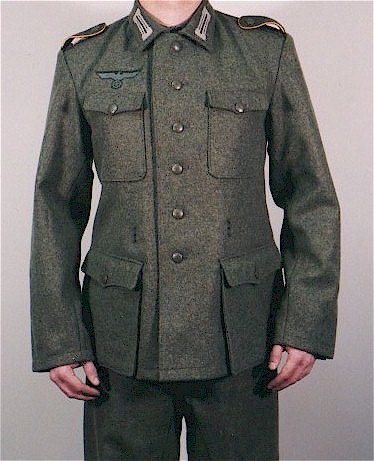 In 1943 a new economy version of the
service uniform was issued, designated M1943. It differed from
the M1936 in both materials and design. It had a distinctly
"utility"appearance, and was greyer than the earlier
uniform. Usually, but not invariably, the pockets had no box
pleats, and straight flaps. The collar was now field-grey instead
of dark green. From this point the detachable shoulder-straps
were also made of field-grey instead of green cloth (It was not
uncommon for the original green straps to be worn on the M1943
tunic by veterans, however.) The silver Tresse on NCO's
collars was progressively replaced by dull grey silk. The green
backing of the collar litzen disappeared, and from then
on the bars were sewn directly to the field-grey of the collar.
As well, the trousers were now made of field-grey material.
In 1943 a new economy version of the
service uniform was issued, designated M1943. It differed from
the M1936 in both materials and design. It had a distinctly
"utility"appearance, and was greyer than the earlier
uniform. Usually, but not invariably, the pockets had no box
pleats, and straight flaps. The collar was now field-grey instead
of dark green. From this point the detachable shoulder-straps
were also made of field-grey instead of green cloth (It was not
uncommon for the original green straps to be worn on the M1943
tunic by veterans, however.) The silver Tresse on NCO's
collars was progressively replaced by dull grey silk. The green
backing of the collar litzen disappeared, and from then
on the bars were sewn directly to the field-grey of the collar.
As well, the trousers were now made of field-grey material.
From 1942 on a modified sidecap began to appear. This had two
small buttons on the front of the turn-up. The eagle-and-swastika
and cockade were now produced on a single piece of backing. The
(^) of Waffenfarbe was not worn on the modified version.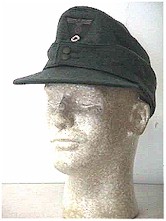
In June 1943 a new field headgear appeared. The M1943 Einheitsfeldmutze - variously translated as either "action field cap" or "replacement field cap"- was developed from the tropical field cap and mountain cap. It was of "ski-cap" shape, with a slightly longer peak than the mountain cap, and was in field-grey cloth overall. The turn-up had two small buttons at the front (though versions with a single button have been seen), and a combined eagle-and-cockade badge was worn on dull green backing on the front of the crown. Officers wore silver-thread badges, and had silver piping round the crown seam. However, both versions of the sidecap continued to be seen until the end of the war.
The final major development came in autumn 1944 with the introduction of the M1944 Feldbluse . It was issued to conscripts and to serving soldiers when their old uniforms needed replacement. Similar in design to the British battledress and American "Ike" jacket, it was waist-length, with six buttons up the front, and was entirely slate-grey. The collar was usually worn open. There were two unpleated breast pockets with straight flaps. Grey litzen were sewn directly to the collar, which does not seem to have been decorated with Tresse by NCOs; their ranking was now shown only on the shoulder-straps. The eagle insignia was worn above the right pocket, usually on a broad, shallow triangle of field-grey backing. The trousers had two slash pockets covered by forward-buttoning flaps, two hip pockets, and a small buttoned "fob" pocket on the front of the right thigh, high up.
Changes to officers' equipment were dictated more by experience than any regulation -- France 1940 was one thing, but Russia 1942 was quite another! One of the few regulated change came in July 1943, when it was ordered that the M1934 officer's belt was to be dyed black, and new belts be manufactured in black. But most of the changes were dictated by the battlefield. Any front line officer who wished to stay alive quickly made changes that made him look more like his men. This meant the abandonment of the officer's belt for the enlisted man's, adopting the enlisted man's tunic, and wearing the sidecap or Einheitsfeldmutze instead of an officer's cap. However, not all officers appear to have made the change. There is a well-known photo of the Canadians capturing a group of Germans at St. Lambert-sur-Dives in 1944. The officer looks like something from France 1940, rather than 1944 -- high boots, Schirmmutze peaked cap, M1936 tunic, M1934 black officer's belt, and what appear to be flared breeches!
The experience of the first Russian winter led to the hasty
design and issue of a proper cold-weather field 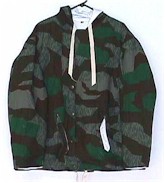 uniform in time for the winter of
1942-43. This was an excellent and popular two-piece reversible
suit, very loose and baggy in appearance, with thick blanket
inter-lining. The suit appeared in two basic patterns; the first
was in "mouse grey" on one side and white on the other,
the second was in camouflage pattern and white. This suit was
completely reversible, all fittings and pocket openings being
duplicated. The jacket buttoned down the right side of the chest
with six buttons, and had two slanted pockets below the waist
with buttoned flaps rounded at the corners. There was an attached
hood, and internal drawstrings pulled the waist, hem, hood and
cuffs tight.
uniform in time for the winter of
1942-43. This was an excellent and popular two-piece reversible
suit, very loose and baggy in appearance, with thick blanket
inter-lining. The suit appeared in two basic patterns; the first
was in "mouse grey" on one side and white on the other,
the second was in camouflage pattern and white. This suit was
completely reversible, all fittings and pocket openings being
duplicated. The jacket buttoned down the right side of the chest
with six buttons, and had two slanted pockets below the waist
with buttoned flaps rounded at the corners. There was an attached
hood, and internal drawstrings pulled the waist, hem, hood and
cuffs tight.
The trousers were of the same material, with drawstring bottoms; they could be worn inside or outside the boots, and were rather shorter in the leg than conventional trousers. The jacket had a button on both front and rear sleeve seams half way down the upper arm, for the attachment of different-coloured cloth armbands as an identification measure. No other insignia were worn on the suit's white side.
The reversible winter uniform was widely used from its introduction until the end of the war. Issue winter caps were also to be seen from 1943 onwards. These were of field-grey cloth with fur or pile on the inside of neck, ear and forehead flaps. The flaps could be laced up over the top of the cap when not in use. The eagle and swastika, and sometimes the cockade, were often sewn to the fur side of the front flap in the form of cap or breast insignia, and metal cap badges were sometimes pinned here by NCOs and officers. Large felt and leather winter boots were also issued from 1942.
It should be mentioned that in photos from the Battle of the Bulge, there is a notable absence of winter clothing. Most photos show German soldiers in their regular tunics, boots and trousers, with only scarves, balaclavas and gloves for protection from the cold. Some also appear to be wearing American greatcoats and raincoats, likely taken from POWs or captured stores. Camouflage clothing on both sides consisted of white bedsheets stitched to shape. Photos also show the Americans identified themselves by painting their sheets with a large circle on the front, back, or both!
Apart from the camouflaged side of the reversible winter uniform, the German Army issued several other camouflaged items, and officers purchased others privately. The pattern employed early in the war, and used throughout, was called the "splinter" pattern. It consisted of geometric shapes in dark green and dark brown on a light green base, with areas of dark green "rain" streaks over the brown and light green. The patches of colour were hard-edged. This pattern was first used on the Zeltbahn or camouflaged shelter-quarter, which could also be worn as a waterproof cape. It was printed with a dark pattern on one side (the base being light green), light on the other (the base being khaki). The camouflaged Zeltbahn was issued as early as 1931, and can be seen throughout the war.
From 1942-43 a second camouflage pattern appeared and was used alongside the first, Usually termed "water" pattern, it featured a much softer mosaic of coloured patches. The base colour was a light tan brown, with large and indistinctly bordered patches of dark brown and dark green. The areas where two colours met were obscured with broad borders of in intermediate khaki shade; light green rain was irregularly over-printed on all colours. Both patterns were used on the camouflage side of the reversible winter uniform.
A baggy lightweight smock was also issued in the mid-war
years. It was collarless, and had a V-neck closed with a
drawstring laced through five eyelets on each side. The tunic
collar was usually worn over the smock neck. The smock reached to
the thighs, and had very loose sleeves buttoned by a tab at the
wrist. there was a prominent seam around the arms above the
elbow, and a ventilation hole in each armpit with a white
binding. A flapped opening on each side of the chest gave access
to tunic pockets and there was a drawstring in the waist. One
side was printed plain white, the other in the first or
"splinter" pattern.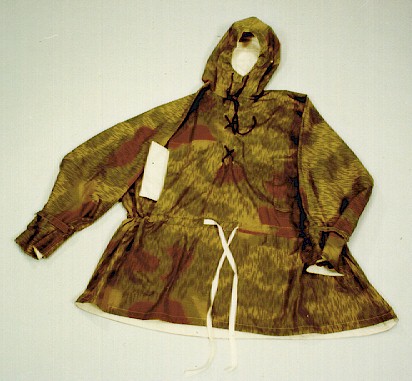
A helmet cover in the same camouflage pattern, with loops for the fitting of foliage and a drawstring to hold it taut under thehelmet rim, was widely used from 1943 onwards. It had a prominent stitched seam pattern, running from front to back and side to side in across the skull in a cruciform arrangement. Smock and helmet cover were worn by all ranks. Loose trousers in the same camouflage pattern were also available, but photos suggest these were not as widely worn.
Also not so widely observed was a special camouflage jacket for officers. This was similar in cut, pockets, button arrangement, etc., to the officers'service tunic. It certainly appeared in "splinter"pattern and possibly in "water" pattern as well.
A new system of sleeve rank patches was
introduced in August 1942, for wear on camouflaged garments and
working denims. These were rectangles of black cloth about 3
15/16 inches (100 mm) wide, and were "stacked" one on
top of the other. Stylized oak leaves were added for officers.
This insignia was worn on the upper left arm only. 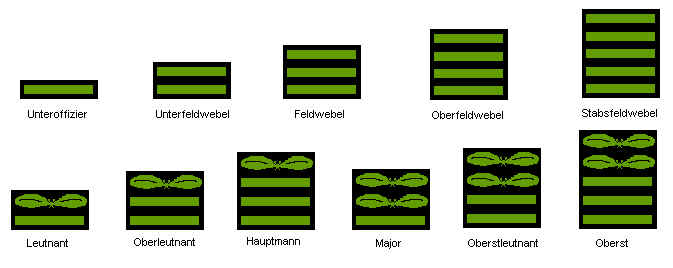
Photos, however, do not show them to have been widely used; rather, both officers and enlisted men wore their normal rank chevrons, shoulder straps, collar patches and even breast eagles on both the reed-green denims and officers' camouflage jackets. Insignia is rarely seen on either the smock or the winter uniform, though strips of cloth, changed every day for security reasons, were often tied around the sleeve of the winter uniform as a means of identification.